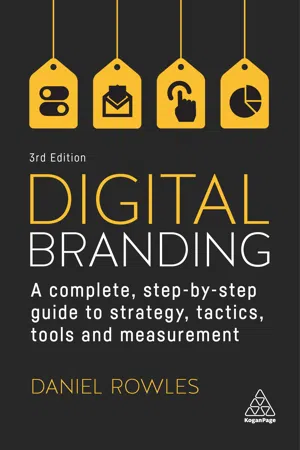
Digital Branding
A Complete Step-by-Step Guide to Strategy, Tactics, Tools and Measurement
- English
- ePUB (mobile friendly)
- Available on iOS & Android
Digital Branding
A Complete Step-by-Step Guide to Strategy, Tactics, Tools and Measurement
About this book
Every decision and action you make contributes to your brand, so it makes sense that everything you do digitally also contributes to your digital brand. Use this bestselling guide to strengthen your brand's online presence and explore core marketing avenues. Digital Branding is ideal for marketers and brand strategists who want to enhance their brand's online presence. It provides step-by-step, practical guidance on how to build a brand online and quantify it through tangible results. Written by a respected Chartered Institute of Marketing (CIM) fellow, course leader and industry thought leader, it examines core marketing areas such as content marketing, social media, search engine optimization and web analytics.The book delivers a robust framework for planning, brand identity, channel selection and measuring the effectiveness of campaigns, and includes lessons from the BBC, Imperial College London and Hootsuite. Now fully updated, this third edition features new content on brand authenticity, ethics and meaning, as well as updates on social media regulations and social media platforms such as TikTok.
Frequently asked questions
- Essential is ideal for learners and professionals who enjoy exploring a wide range of subjects. Access the Essential Library with 800,000+ trusted titles and best-sellers across business, personal growth, and the humanities. Includes unlimited reading time and Standard Read Aloud voice.
- Complete: Perfect for advanced learners and researchers needing full, unrestricted access. Unlock 1.4M+ books across hundreds of subjects, including academic and specialized titles. The Complete Plan also includes advanced features like Premium Read Aloud and Research Assistant.
Please note we cannot support devices running on iOS 13 and Android 7 or earlier. Learn more about using the app.
Information
Digital branding in perspective
Introduction
It’s all digital
Brand awareness as an excuse
What digital branding really means
How digital has changed branding
Global soapbox
Social media fail
Traditional brand metrics
Table of contents
- Foreword by Chris Daly
- Acknowledgements
- Introduction
- Part One Digital branding in perspective
- 01 What digital branding really means
- 02 Focusing on value
- 03 Considering the user journey
- 04 Objectives and authenticity
- Part Two The digital toolkit
- 05 Social media
- 06 Search
- 07 Mobile
- 08 Online advertising
- 09 Email marketing
- 10 CRM and marketing automation
- 11 From integration to transmedia campaigns
- Part Three Digital brand strategy and measurement
- 12 Measuring digital branding
- 13 Primaries and indicators
- 14 The role of analytics
- 15 Bridging the gaps
- 16 The importance of asking questions
- Conclusions
- References and further reading
- Index